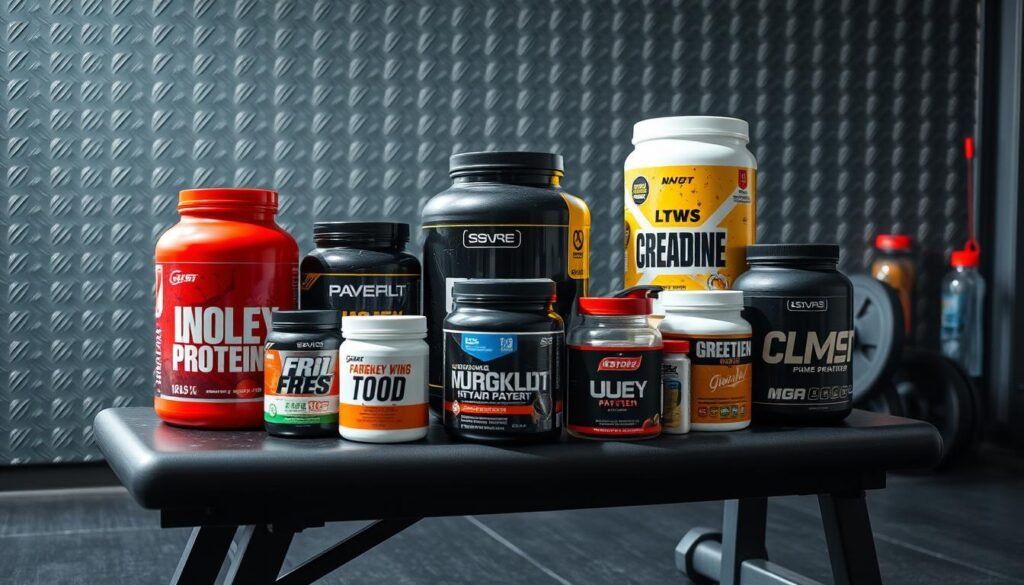A study with 11 male bodybuilders showed those eating more calories gained more muscle in six weeks. This proves that knowing the bulking cutting cycle is key for muscle growth. Bulking isn’t about eating everything you see. It’s about smart eating and training. This helps switch between bulking and cutting, shaping the perfect body.
In the bulking phase, you eat more to grow muscles. The cutting phase is for losing fat but keeping the muscle. Each phase is crucial for your fitness goals. By managing food and exercise in each phase, you can get the best results. Learn more about these phases in this guide on bulking and cutting.
Key Takeaways
- The bulking cutting cycle is essential for optimizing muscle growth and fat loss.
- Proper nutrition and training are crucial during both bulking and cutting phases.
- A caloric surplus is necessary for bulking, typically requiring an increase of 300 to 500 calories per day.
- Setting specific weight gain goals (no more than one pound per week) can prevent excessive fat accumulation.
- Understanding the psychological aspects of bulking and cutting can help mitigate risks linked to disordered eating.
Understanding Bulking and Cutting Phases
To get better muscles, it’s key to know about bulking and cutting. These stages are important in a workout plan. They help you gain muscle or lose fat when needed. Knowing how to switch between bulking and cutting can improve results. It also stops you from gaining too much fat or losing muscle.
What is Bulking?
Bulking is when you eat more calories to grow muscles while keeping fat low. It requires lifting weights and eating a bit more food. Try to gain about one percent of your weight each month in muscle, not fat.
Bulking lasts from four to eight months for growing muscles. You might add 200 to 500 calories to your diet each week. How much depends on how fast your body uses energy. Eating enough protein is very important. Active people should eat more than the usual health advice suggests.
What is Cutting?
On the other hand, cutting helps lower fat while keeping muscle from bulking. This usual takes four to eight weeks. You cut down your food by 200 to 500 calories a day. But, you still need to feel energetic.
Losing some muscle can happen when cutting. Yet, eating right and lifting weights helps you keep muscle. It’s key to continue heavy lifting to stay strong. This matters even when energy or testosterone levels might go down.
| Phase | Duration | Caloric Change | Protein Focus |
|---|---|---|---|
| Bulking | 4 to 8 months | Increase by 200 to 500 calories weekly | Aim for daily intake significantly above minimum recommendations |
| Cutting | 4 to 8 weeks | Decrease by 200 to 500 calories daily | Preserve muscle while aiming for fat loss |
Main Objectives of the Bulking Cutting Cycle
The bulking and cutting cycle has clear goals. It helps change our body by adding muscle or losing fat. By following different phases, we can plan our workouts and diets to reach our fitness dreams. Understanding these goals makes it easier to see real improvements in muscle growth and fat loss.
Goals During Bulking
The main aim of bulking is to grow muscle size. To do this, eating more calories than usual is key. At the same time, lifting heavier weights makes this growth faster. This part usually goes on for 2-3 months. The idea is to gain weight from muscle, not fat. Many men, women, and TGNC folks try bulking. Setting clear targets helps in seeing how well you’re doing.
Goals During Cutting
When we switch from bulking to cutting, the goal changes. Now, the focus is on losing fat but keeping the muscle. This requires eating fewer calories to lose fat without losing muscle. This step needs patience. Early weight loss might be water, not just fat. It’s important to understand how to keep muscle while losing fat. For more on how to manage these cycles, check out this guide.
| Phase | Objective | Duration | Focus |
|---|---|---|---|
| Bulking | Increase muscle mass | 2-3 months | Caloric surplus and strength training |
| Cutting | Reduce fat while maintaining muscle | Varies | Caloric deficit and muscle retention |
How to Start Your Bulking Phase Effectively
Starting your bulking phase requires careful planning. It’s about optimizing muscle gain and minimizing fat. Good preparation means tracking calories and understanding your nutritional needs. It’s crucial for ensuring your body gets what it needs. This includes knowing your caloric intake, macronutrient balance, and planning meals right.
Preparing for Bulking
To start bulking, you need a solid plan. First, figure out your maintenance calories. This is key for knowing how much extra to eat. Men generally need about 3,800 calories a day, and women about 3,200. Aiming for a surplus of 300–400 calories ensures gradual, healthy weight gain. This strategy aims for a 0.25–0.5% body weight increase per week. It promotes muscle growth without too much fat.
Setting Nutrition Goals
Setting nutrition goals is crucial for a successful bulking phase. Aim for a balanced intake of proteins, fats, and carbs. For instance, with a 3,300 calorie plan, your targets would look like this:
| Macronutrient | Grams of Macronutrient |
|---|---|
| Carbohydrates | 371–495 grams |
| Protein | 248–289 grams |
| Fat | 55–110 grams |
Eating nutrient-rich foods helps maintain a balance. It allows enjoying food while getting necessary nutrients. Make adjustments based on progress and preferences. This ensures a personalized approach to building muscle.
Choosing the Right Bulking Cutting Diet
Starting a bulking cutting diet needs a good understanding of food’s role in muscle growth. Each phase, bulking or cutting, needs a different eating plan. Let’s explore the key foods for both phases to gain muscle and lose fat successfully.
Dietary Components for Bulking
The goal of bulking is to grow muscle mass without adding too much fat. Eating enough quality calories is key. Essential elements include:
- Complex Carbohydrates: Eat foods like whole grains, oats, and sweet potatoes. They give you the energy for tough workouts.
- Protein: Getting enough protein helps muscles recover and grow. Try to eat 2.3–3.1 grams per kilogram of your lean body mass throughout the day.
- Healthy Fats: Add avocados, nuts, and olive oil to your diet. They help with hormone production and overall calorie needs.
At the end of bulking, body fat is usually about 15%. Aim to keep body fat between 10-20% for successful cutting later.
Dietary Components for Cutting
Cutting focuses on losing fat while keeping muscle. Changing your meals is key for this stage:
- Reduced Carbohydrates: Eat fewer carbs and more protein. This helps keep muscle while eating fewer calories.
- Higher Protein: Keep protein intake high, at 2.3–3.1 grams per kilogram of your lean body mass, to protect muscles.
- Increased Healthy Fats: During cutting, 15–30% of your calories should come from healthy fats. They help you feel full and keep hormones balanced.
Eat 3–6 times a day, with each meal having at least 20 grams of protein. For better fat loss, add refeed days. These help to keep muscle. Check your weight regularly and stay hydrated to tweak your diet for best muscle growth.

Creating a Bulking Cutting Workout Plan
A well-structured bulking cutting workout plan is important for muscle gain and fat loss. It makes sure you get the best results while staying healthy. Knowing how to train for both bulking and cutting phases will really help your progress.
Training for Bulking
When bulking, focus on lifting heavier weights over time. It’s important to do big exercises like squats, deadlifts, and bench presses. Aim for 8 to 12 reps per set to grow muscles.
Experts suggest eating 1.3g to 1.8g of protein per kg of your body weight daily. For a person weighing 80kg, this means 104g to 144g of protein to help muscles recover and grow.
Training for Cutting
The cutting phase is about keeping muscle but losing fat. High-intensity interval training (HIIT) helps you burn calories well. Add some cardio, but not too much, to avoid losing muscle. Keep workouts intense and watch your calories.
Eating about 1.8g of protein per kg of your body weight is good for keeping muscle. Also, moving more throughout the day helps with weight management.
Here’s a summary of the main differences between bulking and cutting phases in training:
| Aspect | Bulking Phase | Cutting Phase |
|---|---|---|
| Focus | Progressive overload | Muscle preservation |
| Rep Range | 8 – 12 reps | Varied (higher intensity) |
| Cardio Type | Minimal | High-intensity intervals |
| Protein Intake | 1.3g – 1.8g/kg | 1.8g/kg |
| Overall Duration | 3 – 4 months | 8 – 12 weeks |
For more detailed information on bulking and cutting, you can follow this link.
Key Differences Between Bulking vs Cutting
Bulking and cutting play unique roles in fitness. Knowing the differences helps with muscle and fat loss goals.
Bulking involves eating more, about 250 to 500 extra calories daily. It aims for muscle growth with a weekly weight gain target of 0.25–0.5% of body weight. Cutting, however, means eating less, 500 to 750 calories below what’s needed daily, to lose fat. This approach looks for a weekly weight loss of 0.5–1%, keeping muscle intact.

Their diets are different too. Bulking diets are rich in calories, usually with a mix of 40% carbs, 30% protein, and 30% fats. Cutting diets focus on low-calorie, nutrient-packed foods, with 50% proteins, 30% fats, and 20% carbs to lose fat but keep muscle.
The training for each phase is distinct. Bulking workouts include lifting heavy weights for 8-12 reps to grow muscles. In the cutting phase, the goal is to burn calories efficiently. People often do the same amount of workouts but add intense activities like HIIT to lose fat.
| Aspect | Bulking | Cutting |
|---|---|---|
| Caloric Intake | Surplus (250-500 calories above maintenance) | Deficit (500-750 calories below maintenance) |
| Weight Aim | Gain 0.25–0.5% of body weight per week | Lose 0.5–1% of body weight per week |
| Macronutrient Ratio | 40% Carbs, 30% Protein, 30% Fat | 50% Protein, 30% Fat, 20% Carbs |
| Training Focus | Heavy weights, 8-12 reps | Maintain strength, increase intensity |
| Challenges | Potential excess fat gain | Slight muscle loss, increased hunger |
Knowing these differences helps create better muscle gain and fat loss plans. This leads to more effective and successful fitness results.
Bulking Cutting Cycle: Timing and Duration
Knowing when to bulk and cut is key to muscle growth and body composition. Most people bulk for 2 to 3 months. This period allows for a caloric surplus, suggested at 10-20% above maintenance calories for muscle gains. Then, a cutting phase follows for 6 to 12 weeks. This phase focuses on losing fat while keeping as much muscle as possible.
A good bulking diet includes 1.6 to 2.2 grams of protein per kilogram of body weight daily. With the right amount of carbs, 3-7 grams per kilogram, it gives you energy for exercise and recovery. When moving to cutting, reduce calories by 500 to 1000 a day. This helps lose fat without losing muscle. Keeping protein intake high, 1.6 to 2.0 grams per kilogram, helps save muscle during this time.
Different factors decide the best timing and length for bulking and cutting. These include body composition, training goals, and personal schedules. Watching body fat percentage while bulking is important. Aim to not go over a 1% increase in body fat per month. A balanced approach helps in gaining muscle and losing fat effectively. Using strategies to avoid muscle problems is also key to successful cycling.
Essential Bulking Cutting Supplements for Muscle Growth
If you want to get the most out of your bulking and cutting phases, you need to understand bulking cutting supplements. These supplements help with muscle growth and fat loss. They also support your overall fitness nutrition. Here’s a look at some key products to boost your training and recovery:
- Protein Powders: They’re crucial for muscle repair and growth by giving you the amino acids you need. Whey protein gives you over 25 grams of protein quickly.
- Mass Gainers: They’re for those who want more calories during the bulking phase. This helps to ensure you have enough energy for your workouts.
- Creatine Monohydrate: This enhances muscle strength and performance. It’s proven to work.
- Branched-Chain Amino Acids (BCAAs): GAT Sport BCAAs provide 7 grams of essential amino acids. They help reduce muscle damage and improve recovery after training.
- L-Glutamine: This supports recovery. GAT L-Glutamine gives you 5 grams per serving without artificial additives.
The Huge Bulking Stack uses a mix of products that work together to maximize muscle growth and boost performance. During the cutting phase, the Huge Cutting Stack uses ingredients that burn fat and provide important nutrients. This helps you lose fat while keeping muscle mass.

A good bulking and cutting plan includes fitness nutrition that focuses on whole foods. Supplements are extra help for a balanced diet. They support your training goals. The right supplements can boost nitric oxide levels. This improves blood flow to the muscles and helps with nutrient delivery.
| Supplement | Benefits | Recommended Dosage |
|---|---|---|
| Whey Protein | Important for muscle repair and growth | 1-2 scoops daily |
| BCAAs | Helps with less muscle damage and faster recovery | 7g before and after workouts |
| Creatine Monohydrate | Makes your muscle strength better | 3-5g daily |
| L-Glutamine | Helps you recover better | 5g post-workout |
Choosing the correct bulking cutting supplements makes a big difference. Using supplements wisely will help you succeed in your fitness goals.
Maintaining Discipline During Your Bulking and Cutting Cycle
Discipline is key in the bulking and cutting cycles. Following your diet and workout goals is crucial for success. It helps to set real, possible goals for yourself. For instance, aim for weekly weight goals or boosting your workout over time. These goals keep you moving forward.
Keeping track of your progress helps keep you motivated. By logging your workouts and what you eat, you see your wins and places to improve. Using apps or journals for tracking helps you stay true to your fitness journey. They remind you to stick with your plan every day.
Eating the right foods is very important in both bulking and cutting. Planning your meals helps you stick to your nutritional goals. It also stops you from making spur-of-the-moment choices, which isn’t good for reaching your goals. Eating more or less calories, depending on your phase, supports your discipline. For bulking, eat 10-20% more calories. For cutting, eat less than your usual.
Having a workout buddy or a coach makes a big difference. They offer support and keep you going, especially when it’s tough. Sharing your goals with someone who gets it can bring back your focus. Setting times to work out together means encouraging each other to keep going.
Here’s a table showing what can happen when you stick to these tips:
| Cycle | Initial Weight | Final Weight | Weight Change | Duration |
|---|---|---|---|---|
| Bulking | 68 kg | 77.5 kg | +9.5 kg | 12 weeks |
| Cutting | 77.5 kg | 73 kg | -4.5 kg | Ongoing (16 weeks planned) |
Going through bulking and cutting is a journey of the body and mind. With the right approach to discipline and accountability, you are set up to tackle hurdles. This ensures you keep moving towards your fitness goals.
Best Practices for a Lean Bulking Cutting Cycle
Planning and using smart strategies is key for a successful lean bulking cutting cycle. Start by eating whole, nutrient-rich foods. This ensures your body gets all the vitamins and minerals it needs.
Drinking enough water is crucial for your performance and recovery. It keeps your energy up and helps with digestion. Eating your meals at the right times is also important. For those who struggle to gain weight, eating regularly helps keep up energy and nutrients for muscle growth.
Recovery is vital for muscle gain. Taking rest days gives your muscles time to repair and grow. Mix strength training with cardio to stay fit and lose fat. Eating healthy fats, about 20% of your calories, helps keep you lean.
Here’s a look at how your nutrients change in different phases:
| Phase | Protein (grams) | Carbohydrates (grams) | Fats (grams) |
|---|---|---|---|
| Bulking | 200 | 429 | 80 |
| Cutting | 200 | 250 | 60 |
Progressive overload is key to building muscle. Focus on compound lifts to gain muscle and strength. Lifting 3 to 4 days a week is good for growing mass. More experienced lifters may progress slower.
With these tips, you can confidently go through your lean bulking and cutting cycle. This leads to lasting muscle growth and effective weight management.
Conclusion
Mastering the bulking cutting cycle is key for anyone looking to grow their muscles. It means eating right, working out well, and using supplements when needed. Those who follow this cycle see big changes in their body by staying disciplined.
Building muscle and then making it look defined takes true commitment. When bulking, you need 200-500 extra calories each day for muscle growth. It’s important to eat at least 1 gram of protein per pound of body weight. Then, when cutting, the goal is to lose fat but keep your muscle. Try to reduce about 10% body fat in 12 weeks.
To wrap up, the bulking and cutting cycle is more than changing how you look. It’s about adopting a healthier lifestyle. This journey toward muscle growth should be mindful. It will improve your strength and your overall health.